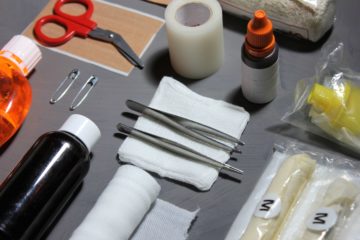Scene. You’re burnt out and stressed from work, you’re ready to get some fresh air and you’ve decided to go for a hike. You’re getting ready, packing up all of your hike essentials, and you are almost ready to go, just got to grab some H20. You are educated enough to understand that a hike is exercise and during exercise, especially in the sun, you need to hydrate!

If only we could carry a whole coconut on a hike! 😉 The best kind of hydration!
…but how much water do you need? There’s so much conflicting information out there on how much water one should drink per day. Drink half your weight in ounces. Drink 8 glasses per day. Drink more if this. Drink less if that. How can one decipher between all this information?
Well, today I am going to break it down for you and make it simple.
How Much Water to Take Hiking Table of Contents
Obviously, we all know that water is important. But just in case we don’t fully understand why, I will tell you. Our bodies are made of roughly 70% water. Water is responsible for nourishing our cells, joints tissues, and more! Water helps flush out waste and toxins that we expose our bodies to on a regular basis and helps regulate our body temperature.
As I mentioned in my post about what to bring on a day hike, WATER 

How much water should you drink per day
According to the Mayo Clinic, men need about 15.5 cups (3.7 liters) per day and women need 11.5 (2.7 liters). Web MD states that 13 should be enough for men and 9 cups for women. In a separate article, titled differently, Web MD mentions calculating half to one ounce of water per pound of bodyweight, meaning if you weigh 150 pounds, drink 75-150 ounces (roughly 9-19 cups!) per day. WHAT.
Yeah, my mind is a little blown reading these articles to create this post for you! 150 ounces a day??

Just drink the whole waterfall, why don’t you?
This makes sense though because there are so many different factors that go into calculating your water intake. We must be aware of our own bodies. When exercising, for example, we must drink more than if we are sedentary. Pregnant women need more water. If you are dehydrated or have diarrhea, you need more water. There are many factors that go into calculating how much to drink.
Ultimately, you should aim for staying between these guidelines above and listen to your body. Drink when you feel thirsty (and sometimes even if you don’t!) and pay attention to the color of your pee. If it is clear or light yellow, you are drinking enough!
If you are having any symptoms of dehydration such as headache, dry mouth, or nausea and you have NOT been meeting even the lowest daily recommendation, there’s probably a good chance you’re not drinking enough.

This poor pup was suffering some dehydration on a Volcano Trail. Fortunately, my friend shared some of his and revived him
Personally, I prefer to follow the calculated ounces rather than the “men drink this much, women drink this much” because we are all different body weights, so calculating our water intake makes the most sense to me. There are even online resources for calculating this per individual such as this one here. Try it out! (Back to Top)
How much water to take hiking?
Well. We already mentioned how to figure out how much water you need to drink per day based on your age, weight, activity level etc. A hike is a form of activity so you want to add that into your exercise calculations. Additionally, hikes vary in length, difficulty, and time to complete and this has to be considered when deciding how much water to take hiking.
For example, there are hikes near my house that are under a mile long. I probably don’t even need to carry water with me as long as I drink before and after. Then there are long day hikes like my recent 23 miles in one day accomplishment, where obviously I’m going to need a lot of water (and a lot of food and electrolytes too!)
As you can see, there are a lot of differing factors here, so the best advice I can give you to know how much water to take hiking would be just trial and error. Make your best guess using the calculator above and then divide how much you will need per day by how long your hike will take. Especially if you’re new to hiking, ALWAYS 




My friend knows the importance of water. He’s got a whole bag full. 
Another general rule of thumb for hikes (similar to the general rules of thumb about how much men and women should drink per day) is
- Adults: 2 cups of water per hour of hiking
- Kids: 1-2 cups of water per hour of hiking
Again, you must factor in other circumstances. For example, I drink a lot, like to the point where my friends make comments about how much I drink. I have another friend who doesn’t drink much at all and survives all of our hikes. I do recommend NOT following in her footsteps.
Other things you may want to consider in calculating how much water to take hiking are:
- Weather: is it a hot and humid hike? Bring more.
- Hike Difficulty: Is it an extra strenuous hike? Bring more.
- Do you have a filter? I will discuss this more below.
Best ways to carry water on a hike
Now that we’ve figured out how much water to take hiking, we must decide on how we will carry all that water. There are multiple options for carrying water. If you are new to hiking, you will most likely grab a disposable water bottle as a last minute thought. I urge you against this not only because it probably is too small (unless you are doing a really short hike), but also because it’s one time use plastic.
And we all know based on my youtube videos how I feel about single-use plastic if avoidable (No one is claiming to be perfect here!). Hopefully, if you are reading my post, you choose a more sustainable option and pick a reusable container.

Unfortunately some types of water only come in single-use bottles 🙁 But you can reuse these!
Stainless steel is very popular these days. It’s good if you want to keep your beverage cold or hot a little longer. I personally don’t recommend it for a hike just due to the weight of it, but if you’re up to carrying it, you do you. There are certain shorter hikes where I’m not carrying much else where it would be okay to haul in a stainless bottle. A friend of mine has a reusable plastic bottle like this that has little motivational tags on the side of the bottle to help you keep track of how much you’re drinking.
Nalgene (or similar style) water bottles are also a popular reusable bottle choice, but I find the lids too hard to drink out of without spilling! (I bought a little insert for mine that redirects the water into a smaller pour). You can use any standard reusable bottle, but if you are looking to reduce the weight of your pack, you may want to opt for one of these lightweight options seen here.
Another great choice is a water bladder. This is a convenient little pouch of water that goes in your backpack and comes through a straw so you can conveniently walk without stopping to pull a bottle out of your bag whenever you’re thirsty or carry a bottle the whole hike in your hand. (Hello, you need that hand for taking pictures!)

You gotta keep one free hand on that phone camera so you don’t miss a beat!
A water bladder is my water container of choice. I have used both a Platypus EVO 3L water bladder and a Camelback… It’s been a while since I’ve had the camelback, so I don’t feel comfortable giving a full review, but you can read my honest review of the Platypus in a future blog post. (Back to Top)
Consider taking a water filter
Lastly, if you are going on a hike near a body of freshwater, you could always go ultra-light and carry just a filter. Typically for a day hike, I will just carry what I need, but for an overnight hike, a filter is necessary! If you want to know what else to pack for an overnight hike, click here.
A good time to test out a filter is on a day hike, so it is most definitely an option to carry a filter as your main water source. Just make sure there is plenty of water on the trail! And make sure your filter has an attached bottle to put the clean water in.

Pictured: Sawyer Squeeze filter & Osprey hydration bladder
If you’re looking for a good filter, these are the most recommended:
- Sawyer Squeeze (I personally find this one to be a little slow, but this is probably the most popular filter that exists)
- LifeStraw (I love their charity program: every purchase provides clean water for a child in need for a whole year, BUT I do not find the product to be convenient for backpacking trips, as you can see it’s heavier than it’s competitors)
- Katadyn Befree (this is what I use and love! There were some complaints about the flavor of silicone and my first bag leaked, but I like it because it filters SO FAST. The bag leak did not deter me because they immediately sent me a new one for free)
A filter is not the only way to treat your water, however. In fact, it does not get rid of VIRUSES, but for most hikes you are on, a filter is the way to go. For a full understanding of what kind of filtration system to use, stay tuned for a future post. (Back to Top)
Final recap
Okay! So today we covered how to calculate how much water you should drink per day and how to tell if you might be dehydrated. Once you are relatively aware of that, it’s easier to figure out how much water to take hiking, where we discussed that you can calculate that or follow the general rule for adults and kids.
We then discussed several ways to carry water hiking such as reusable water bottles in stainless or plastic, water pouches, or water bladder systems. And lastly we mentioned taking a water filter, with my top recommendation being a Katadyn Be Free filter.

My Katadyn Be Free filter comes in two sizes!
Aside from water, there are several other things to consider bringing on a hike. This is my go-to list of items I like to take with me (clothing varies depending on temperatures):
- Samsung Galaxy S20 & Tripod
- Cotopaxi Luzon Del Dia 18 L backpack
- Altra Superior 4 Trail Runners
- Black Diamond Spot 350 Headlamp
- Platypus Evo 3L Hydration Bladder
- Katadyn BeFree Water Filter
- Smartwool Zip Top 250 Midweight Base Layer
- Helly Hansen Rain Jacket
- a lacrosse ball for in-hike massaging
- Ultima Replenishers Electrolyte Powder
- KT tape
- Moleskin
- REI sock liners
- Trowel & toilet paper/trash bags
- a generic pair of sport shorts, a tank top, and sports bra
- food
- trekking pole
- first aid gear
For a full description of what to take on a day hike, please see this post about day hike essentials. If backpacking is your jam, check out this post here. (Back to Top)






0 Comments